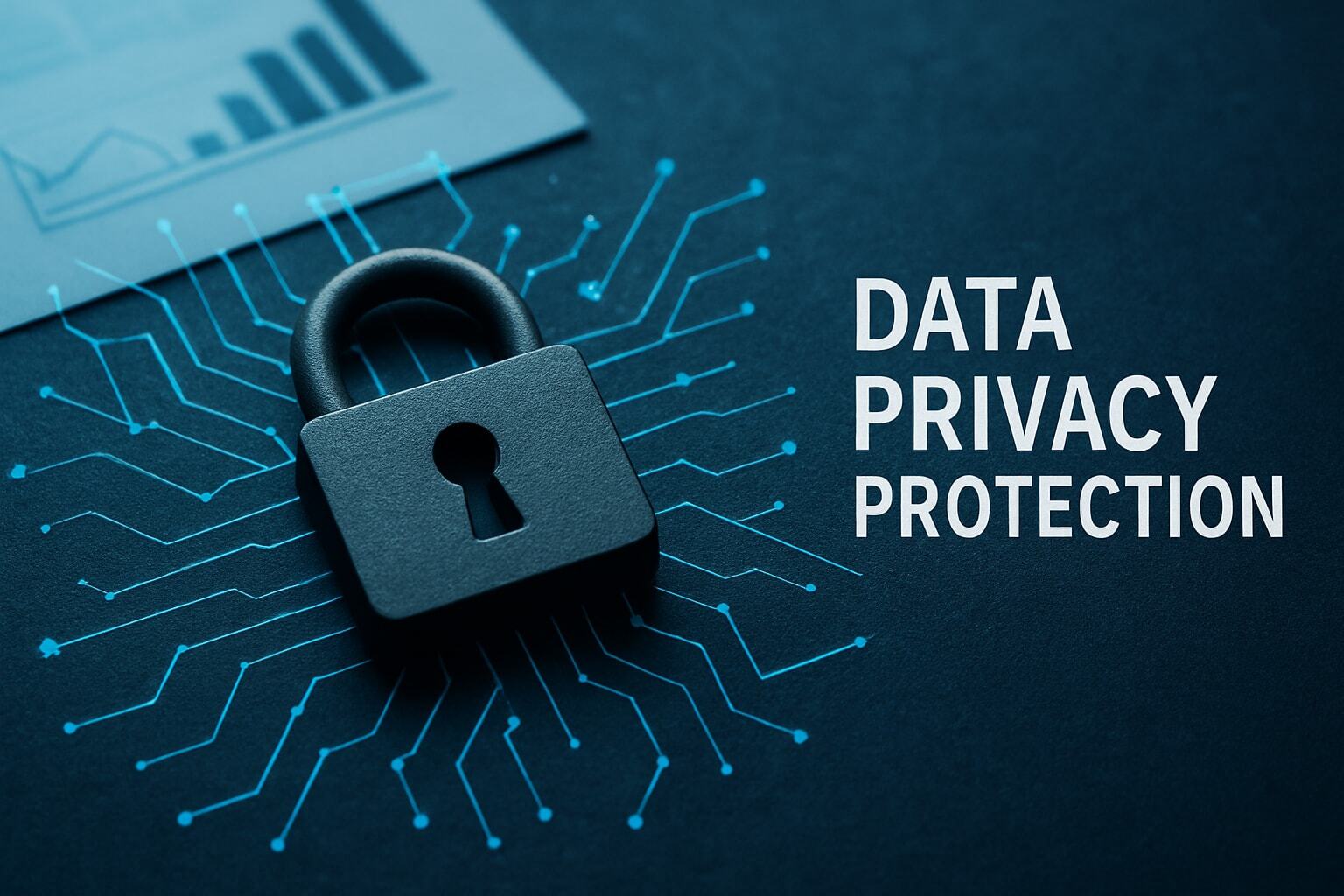Essential Guide to Data Privacy Protection in 2025
n 2025, data privacy protection is more critical than ever. Over 80% of organizations faced data breaches in 2024, making privacy risks impossible to ignore. New regulations and advanced cyber threats are reshaping how we live and work online.
This essential guide reveals the latest privacy threats, regulatory shifts, and emerging technologies. You will find practical strategies and tools to protect your sensitive data and reputation. Ready to future-proof your privacy? Read on and take control of your digital world.
The Evolving Data Privacy Landscape in 2025
The world of data privacy protection is facing unprecedented change in 2025. Digital transformation, advanced cyber threats, and sweeping regulations are rewriting the rules for both individuals and organizations. Staying current with the evolving landscape is essential for anyone aiming to safeguard sensitive information and maintain trust.

Major Trends Shaping Data Privacy
Several trends now define the data privacy protection environment. The rapid shift to remote work and widespread cloud adoption have multiplied the locations where data is stored and accessed. This expansion creates new exposure points.
The proliferation of IoT devices, AI applications, and mobile platforms means personal data is collected at an unprecedented scale. Cybercriminals are leveraging more sophisticated attacks, including targeted ransomware and automated exploits. Biometric and health data are increasingly used in everyday services, raising unique security and ethical concerns.
Global digital services now cross borders, making jurisdiction and compliance more complex than ever. According to Cloudian, 70% of organizations stored sensitive data in the cloud in 2024, highlighting the urgent need for robust data privacy protection.
Key Data Privacy Threats
The threats to data privacy protection continue to intensify. Ransomware remains a leading risk, with 66% of enterprises targeted in 2024. Insider threats, whether malicious or accidental, result in damaging leaks. Social engineering and phishing attacks are more convincing and harder to detect.
Third-party vendors can introduce vulnerabilities, especially if their security practices are lacking. Data scraping and unauthorized profiling are on the rise, often exposing sensitive details without user consent.
For a deeper look at these risks and the best ways to defend against them, see this guide on Cybersecurity and digital threats. Staying informed is central to effective data privacy protection in 2025.
The Role of Emerging Technologies
Emerging technologies offer both challenges and solutions for data privacy protection. Artificial intelligence and automation are now used to manage privacy settings, monitor data flows, and detect anomalies in real time. Privacy-enhancing technologies, such as tokenization and anonymization, help reduce risk by masking sensitive information.
Blockchain technology creates transparent, immutable records of data access and sharing. Meanwhile, quantum computing is expected to disrupt current encryption standards, prompting research into quantum-safe algorithms. Organizations must adapt their data privacy protection strategies to keep pace with these innovations.
Consumer Awareness and Expectations
Consumer expectations for data privacy protection have evolved rapidly. The public is more aware of data misuse and demands greater transparency from organizations. People want clear explanations about how their information is collected, used, and shared.
There is a growing preference for brands that prioritize privacy, with 60% of consumers in 2024 stating they favor businesses with strong privacy policies, according to the World Bank. Many now use encrypted messaging, privacy browsers, and other protective tools. Companies that meet these expectations can build lasting trust through effective data privacy protection.
The Cost of Data Breaches
The financial and reputational costs of weak data privacy protection are higher than ever. In 2024, the average cost of a data breach reached $4.45 million, based on IBM research. Beyond immediate losses, organizations face long-term damage to customer trust and brand reputation.
Regulatory penalties for non-compliance add further risk, and legal liabilities can persist for years. High-profile breaches in healthcare and finance illustrate the severe impact of failing to invest in strong data privacy protection.
Global Data Privacy Laws and Regulatory Updates
Understanding global data privacy protection has never been more important. In 2025, regulations are evolving rapidly, driven by new threats and the expanding digital economy. Organizations and individuals must stay informed to ensure compliance and minimize risk. This section explores the current landscape, key principles, complex cross-border issues, enforcement trends, and how to prepare for upcoming changes.

Overview of Major Data Privacy Regulations in 2025
The regulatory environment for data privacy protection is increasingly complex. The European Union's General Data Protection Regulation (GDPR) remains a gold standard, with strict rules on consent, transparency, and user rights. California's CCPA and its amendment, CPRA, continue to strengthen consumer data rights in the United States.
Other regions are not far behind. Brazil's LGPD, India's DPDP Act, China's PIPL, and new African laws reflect a global shift toward comprehensive protections. International frameworks like the OECD Privacy Principles and Convention 108+ help align standards across borders. Staying current is essential, as regulations often have extraterritorial reach, affecting organizations worldwide.
Key Principles of Modern Data Protection Laws
Modern data privacy protection laws share several core principles. These include lawfulness, fairness, and transparency in processing personal information. Purpose limitation ensures data is collected only for specific, legitimate reasons.
Data minimization and accuracy are critical, reducing risks by holding only necessary and correct information. Storage limitation mandates that data is not kept longer than needed. Accountability requires organizations to demonstrate compliance, while user rights such as access, correction, and consent put individuals in control. Article 5 of the GDPR remains a global benchmark, inspiring similar clauses in new regulations.
Cross-Border Data Transfers and Localization
Cross-border data flows are a central challenge in data privacy protection. Many countries now restrict personal data transfers to locations lacking adequate safeguards. Standard contractual clauses and adequacy decisions are common tools for legal transfers.
Data localization laws in China, Russia, and India require certain information to stay within national borders. The UK's Data (Use and Access) Act 2025 introduces new requirements for international data sharing, impacting both local and global businesses. These changes demand careful planning and legal review for any organization operating internationally.
Regulatory Enforcement and Penalties
Regulators are increasing enforcement efforts to ensure robust data privacy protection. Under the GDPR, organizations face fines up to 4 percent of global turnover for serious violations. Supervisory authorities like the UK ICO and the Philippine National Privacy Commission have expanded powers to investigate, audit, and penalize noncompliance.
Mandatory breach notification requirements are now standard, forcing organizations to report incidents quickly. South Africa’s Information Regulator exemplifies the growing trend of proactive oversight. For businesses, the cost of noncompliance extends beyond fines to reputational harm and customer loss.
Preparing for Upcoming Regulatory Changes
Proactive adaptation is key to ongoing data privacy protection. Organizations should monitor legislative trends, including proposed amendments and new laws. Updating privacy programs, training staff, and reviewing contracts help ensure readiness for new requirements.
Engaging legal counsel and compliance experts provides guidance through complex changes. Building a culture of privacy by design, where protection is integrated from the start, positions organizations for long-term success. Continuous improvement and awareness are essential as the legal landscape keeps evolving.
Building a Robust Data Privacy Protection Program
Protecting sensitive information in 2025 requires a holistic approach. A robust data privacy protection program is not a one-time effort but an ongoing commitment. Organizations must address technical, administrative, and human factors to stay ahead of threats and comply with evolving laws. Let us break down the essential steps for building a successful framework.

Assessing Privacy Risks and Data Inventory
The first step in data privacy protection is understanding what personal data you collect and where it resides. Begin by mapping all data flows across your organization. Identify touchpoints where data enters, moves, and is stored, whether on-premises or in the cloud.
Next, categorize data by sensitivity. Health records, biometric identifiers, and financial details are high-risk and need extra safeguards. Use data mapping tools to visualize and track data movement, which is especially critical for multinational companies handling cross-border information.
Conduct Privacy Impact Assessments (PIAs) before launching new projects or systems. These assessments help highlight vulnerabilities and ensure compliance with regulations. By proactively identifying risks, organizations can prioritize resources and reinforce data privacy protection where it matters most.
Implementing Technical Safeguards
Technical controls are at the core of any data privacy protection strategy. Encrypt all sensitive data, both at rest and in transit, using strong algorithms. Consider anonymization and pseudonymization to reduce the risk of exposure if data is breached.
Multi-factor authentication and strict access controls restrict unauthorized entry. Regularly test your systems for vulnerabilities and patch weaknesses promptly. Automated tools can scan for misconfigurations and compliance gaps.
For practical advice on securing and storing sensitive data, review these data security and storage tips. These best practices help ensure that your technical safeguards remain up to date as threats evolve. Remember, the effectiveness of data privacy protection depends on consistent technology upgrades and vigilant monitoring.
Administrative and Organizational Measures
Beyond technology, data privacy protection relies on strong administrative controls. Appoint a Data Protection Officer (DPO) or privacy lead to oversee compliance efforts. Develop clear, accessible privacy policies outlining how data is collected, used, and protected.
Employee training is essential. Educate staff on recognizing phishing attempts, handling sensitive data, and following secure procedures. Regular awareness campaigns reduce the risk of accidental leaks or internal breaches.
Vendor management is another critical layer. Assess third-party partners for their privacy practices and require contractual commitments to data privacy protection. Conduct due diligence and monitor ongoing compliance to minimize external risks.
Privacy by Design and Default
Integrating privacy into every stage of product or service development is a core principle of data privacy protection. Adopt privacy by design, where privacy considerations are embedded from the start, not added later.
Limit data collection to what is strictly necessary for your business purpose. Default settings should favor privacy, such as minimal data retention and restricted access. Regular audits help identify areas for improvement and ensure compliance with privacy standards like the GDPR.
Continuous improvement cycles, informed by lessons learned and regulatory updates, keep your privacy program resilient. Privacy by design is not just a legal requirement but a competitive advantage in building customer trust through data privacy protection.
Data Subject Rights Management
Modern data privacy protection programs must empower individuals to control their personal data. Facilitate access, correction, and deletion requests through streamlined processes. Make it easy for users to manage their consent and withdraw permission at any time.
Automate rights management with dedicated tools that track and respond to requests efficiently. Provide clear communication channels for inquiries and complaints. Transparency builds user confidence and demonstrates your commitment to privacy rights.
By respecting and enabling data subject rights, organizations fulfill legal obligations and enhance their reputation for responsible data privacy protection.
Incident Response and Breach Management
Preparation is key to minimizing damage from data breaches. Develop and test a comprehensive incident response plan covering detection, containment, and recovery. Assign clear roles and responsibilities so everyone knows what to do if a breach occurs.
Establish notification procedures to inform affected individuals and authorities promptly, as required by regulations like the GDPR. Post-incident analysis helps identify root causes and prevent future incidents.
Regular drills and updates ensure your team stays ready. Effective breach management is a cornerstone of any data privacy protection program, safeguarding both organizational integrity and customer trust.
Data Security Technologies and Best Practices
Securing sensitive data is the backbone of effective data privacy protection. With cyber threats evolving daily, organizations must adopt a layered defense strategy using advanced security technologies and best practices. This section explores the core pillars of modern data privacy protection, providing actionable insights for 2025.

Encryption and Data Masking
Encryption stands as a fundamental safeguard for data privacy protection. Organizations rely on multiple encryption types, such as symmetric encryption for speed, asymmetric for secure key exchange, and homomorphic encryption for processing encrypted data without decryption. Data masking is equally vital, especially when using test environments or analytics, ensuring sensitive details are never exposed.
Key management is a challenge for large organizations, requiring robust policies and secure storage. Regulatory frameworks like GDPR and CCPA mandate strong encryption for protected data. For families and businesses, secure document storage solutions offer a practical approach to safeguarding important files and maintaining data privacy protection.
Access Control and Authentication
Controlling access is pivotal for data privacy protection. Modern systems use role-based access control (RBAC) and attribute-based access control (ABAC) to ensure only authorized individuals can reach sensitive data. Multi-factor authentication (MFA) adds another layer, making unauthorized access significantly more difficult.
Organizations should follow the principle of least privilege, granting users only the permissions they need. Continuous monitoring and detailed logging of access attempts help identify suspicious activity early, strengthening your data privacy protection posture.
Network and Endpoint Security
Network and endpoint security are central components of data privacy protection. Firewalls and intrusion detection/prevention systems (IDS/IPS) guard the network perimeter, while endpoint protection platforms manage device security. Mobile device management tools help secure remote and mobile users, reducing potential vulnerabilities.
Patch management is crucial, as unpatched systems often serve as entry points for attackers. Regular vulnerability remediation ensures that known weaknesses are addressed promptly, mitigating risks to data privacy protection.
Data Loss Prevention (DLP) Solutions
Data Loss Prevention (DLP) technologies are essential for data privacy protection, monitoring data movement across networks and devices. Automated policies can block unauthorized transfers, whether through email, cloud storage, or removable drives.
DLP solutions often integrate with existing security tools, providing comprehensive visibility and control. In healthcare, for example, deploying DLP has helped organizations prevent accidental or malicious data leaks, supporting compliance and robust data privacy protection.
Continuous Monitoring and Threat Intelligence
Continuous monitoring reinforces data privacy protection by detecting anomalies in real time. Advanced systems leverage AI and machine learning to spot suspicious patterns or unauthorized access attempts quickly.
Threat intelligence feeds supply up-to-date information on emerging risks, enabling organizations to adapt their defenses proactively. Many international standards now require ongoing security assessments, ensuring that data privacy protection evolves alongside new threats and technologies.
Privacy-Enhancing Technologies (PETs) and Future Innovations
The landscape of data privacy protection is rapidly evolving, driven by the adoption of privacy-enhancing technologies (PETs). In 2025, PETs play a vital role in supporting compliance, building trust, and empowering both organizations and individuals to manage sensitive information responsibly.
PETs help minimize personal data exposure while enabling valuable analytics and business operations. Their adoption is accelerating in sectors such as finance, healthcare, and retail, where handling large volumes of sensitive data is routine.
Overview of PETs in 2025
PETs are a diverse set of tools and methods that support data privacy protection. Organizations use PETs to anonymize, aggregate, or encrypt data, reducing exposure while still extracting value.
Common PETs include:
- Anonymization: Removing identifiers from datasets for safe analysis.
- Differential privacy: Adding statistical noise to prevent re-identification.
- Federated learning: Training AI models locally on devices, keeping personal data decentralized.
The growing importance of PETs is clear as more organizations seek to comply with global privacy laws and meet consumer expectations. Data privacy protection strategies increasingly depend on these technologies to ensure sensitive information remains secure.
AI and Automation in Privacy Management
Artificial intelligence is transforming how organizations approach data privacy protection. AI can automate complex tasks such as data classification, risk assessment, and consent management, reducing the risk of human error and streamlining compliance.
For example, AI-driven tools can scan vast data stores to identify sensitive information and enforce privacy rules automatically. Automated systems also respond faster to potential threats or policy violations. To address privacy risks in AI models themselves, researchers have proposed frameworks for mitigating personally identifiable information, such as the Adaptive PII Mitigation Framework for Large Language Models.
By integrating AI with other privacy-enhancing technologies, businesses can maintain robust data privacy protection even as their data environments grow more complex.
Blockchain and Decentralized Privacy Solutions
Blockchain technology is gaining traction as a tool for data privacy protection, offering tamper-resistant and transparent records of data access and sharing. By leveraging decentralized ledgers, organizations can create immutable audit trails that enhance accountability and reduce the risk of unauthorized changes.
Smart contracts, another blockchain innovation, help automate compliance by ensuring that data usage follows strict, predefined rules. However, blockchain solutions also face challenges such as scalability and regulatory uncertainty.
Despite these hurdles, the potential for blockchain to strengthen data privacy protection remains significant, especially for industries requiring high levels of trust and traceability.
Preparing for Quantum-Safe Privacy
Quantum computing poses a future threat to traditional encryption, which is foundational to data privacy protection. As quantum capabilities advance, organizations must prepare by researching and adopting post-quantum cryptography.
Key steps for future-proofing data privacy protection include:
- Identifying systems that rely on vulnerable encryption methods
- Testing quantum-resistant algorithms in controlled environments
- Collaborating with industry experts to monitor quantum research
Proactive planning ensures that data privacy protection strategies remain effective as new technologies emerge. Staying ahead of quantum threats is essential to safeguard sensitive information in the years to come.
Institutional Oversight, Accountability, and User Empowerment
Institutional oversight forms the backbone of effective data privacy protection. In 2025, ensuring robust privacy standards means organizations and governments must work together to build trust, enforce compliance, and empower users. With increasing digital threats and regulatory expectations, oversight and accountability are now essential pillars for safeguarding sensitive information.
Role of Supervisory Authorities and Oversight Bodies
Supervisory authorities are central to data privacy protection. Their main functions include monitoring compliance, investigating potential violations, and enforcing data protection laws. These bodies, such as the Estonian Data Protection Inspectorate, operate independently and are equipped with specialized resources to handle complex privacy cases.
They often collaborate internationally to address cross-border data flows and coordinate enforcement actions. For example, after the 2024 National Public Data breach, supervisory authorities worldwide intensified efforts to improve regulatory frameworks and information sharing. Such incidents underscore why strong oversight is vital to preventing future breaches and ensuring ongoing data privacy protection.
Organizational Accountability Measures
Organizations bear significant responsibility for data privacy protection. Accountability measures are not optional; they are a legal and ethical necessity. Key practices include:
- Maintaining detailed records of all data processing activities
- Conducting regular internal and external audits
- Fulfilling reporting obligations to relevant authorities
Transparency initiatives, such as publishing privacy impact assessments, further reinforce a culture of accountability. By embedding these measures into daily operations, companies demonstrate their commitment to data privacy protection and regulatory compliance.
User Rights and Redress Mechanisms
Empowering users is a cornerstone of data privacy protection. Modern regulations grant individuals clear rights to access, correct, and delete their personal data. Effective redress mechanisms ensure that users can file complaints and have their concerns addressed promptly.
Organizations should provide:
- Simple procedures for data requests
- Transparent processes for dispute resolution
- Direct communication channels to data protection officers
Ombudsmen and national data protection agencies play a crucial role in resolving disputes and upholding user rights, strengthening public trust in data privacy protection.
Public Awareness and Education Initiatives
Public awareness initiatives are essential for widespread data privacy protection. Education empowers individuals to make informed choices about their personal data and recognize potential risks. National and global campaigns, such as Data Privacy Day, help promote privacy literacy.
These campaigns often include:
- Workshops and seminars on privacy rights
- Online resources and toolkits for individuals and small businesses
- Collaborations with schools and community organizations
By fostering a privacy-aware culture, society as a whole becomes more resilient against data misuse, supporting long-term data privacy protection.
Case Studies of Effective Oversight and Empowerment
Real-world examples highlight how oversight and empowerment drive data privacy protection. South Africa’s Information Regulator has successfully combined public education with enforcement to raise privacy standards. The UK ICO is recognized for its clear guidance and transparent reporting.
In the Philippines, the National Privacy Commission’s robust complaint handling and cross-border cooperation offer a model for emerging economies. These case studies demonstrate that effective oversight, user empowerment, and proactive measures are key to achieving comprehensive data privacy protection in a complex digital landscape.
The Future of Data Privacy: Challenges and Opportunities
As organizations look ahead, the landscape of data privacy protection is rapidly changing. The future brings both significant challenges and exciting opportunities for individuals and businesses alike. Staying proactive is essential as innovation, new threats, international standards, and workplace culture all shape the next era of privacy.
Balancing Innovation and Privacy
Balancing data-driven innovation with data privacy protection requires careful planning. Companies are eager to use artificial intelligence and big data analytics to deliver smarter products, yet they must safeguard personal information at every stage.
Ethical considerations are central. For example, using privacy-enhancing technologies allows companies to share insights without exposing individuals. This approach enables responsible data use while still protecting privacy.
Organizations should:
- Evaluate new technologies for privacy risks
- Apply privacy-by-design principles in development
- Train teams on ethical data use
Finding the right balance is not just about compliance but about building trust.
Anticipating New Threats and Technologies
The threat landscape for data privacy protection is evolving. Cybercriminals are leveraging deepfakes, synthetic data, and advanced profiling tools to bypass traditional defenses. State actors are also increasing their cyber activities, targeting sensitive sectors with sophisticated attacks.
Organizations must prepare for unknown risks. This includes:
- Staying updated on emerging threat trends
- Investing in threat intelligence and monitoring
- Regularly updating incident response plans
Proactive defense and adaptability are key. By anticipating changes, companies can reduce vulnerabilities before they become critical issues.
The Global Move Toward Privacy Standardization
International efforts to harmonize privacy laws are shaping the future of data privacy protection. Fragmented regulations have challenged global businesses, but new frameworks like Convention 108+ aim to simplify compliance and promote trust across borders.
Harmonization benefits both consumers and companies, making international digital trade smoother. For an in-depth analysis of U.S. privacy law developments and global trends, see the US Cybersecurity and Data Privacy Review and Outlook 2025.
Standardization will help organizations streamline processes and protect user rights consistently worldwide.
Building a Culture of Privacy for the Next Decade
The future of data privacy protection depends on more than just technology and regulation. Embedding privacy into organizational values creates a sustainable culture of trust. Empowering both employees and users as privacy advocates ensures ongoing vigilance.
Key steps include:
- Integrating privacy objectives into company strategy
- Providing regular privacy education
- Encouraging feedback and continuous improvement
A strong privacy culture enables organizations to adapt to legal, technical, and social changes, making data privacy protection a core element of long-term success.
As we've seen, protecting your personal and family data in 2025 means staying ahead of new threats and making smart choices about where your most vital information lives. Whether you're organizing estate plans or safeguarding emergency instructions, having a secure digital vault you can trust gives you true peace of mind. IronClad Family is built for this new era of privacy, empowering you to keep everything safe, private, and accessible for those who matter most. If you’re ready to take control of your digital security, you can Start 14 Day Free Trial and see how easy it is to future proof your privacy.

Michael Lester
I spent years flying Marine Corps combat missions believing I understood America’s role in the world. Today I work in national security and cybersecurity, helping organizations understand risk, resilience, and the systems we rely on. My writing continues the same mission—bringing clarity to complex issues and inviting people to look past slogans so we can understand who we are, what we do in the world, and why it matters.



